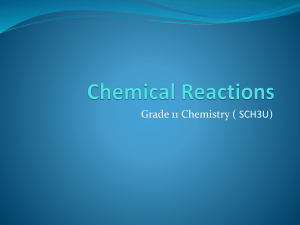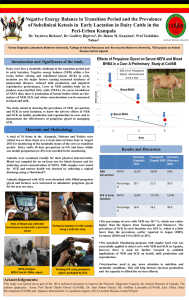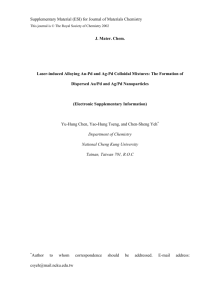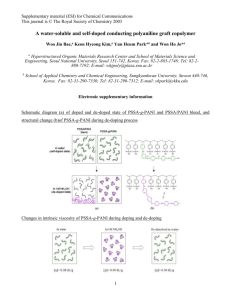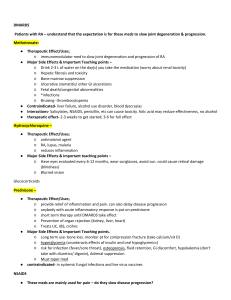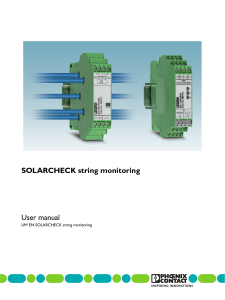(SCK) Nanoparticle Conjugates
advertisement
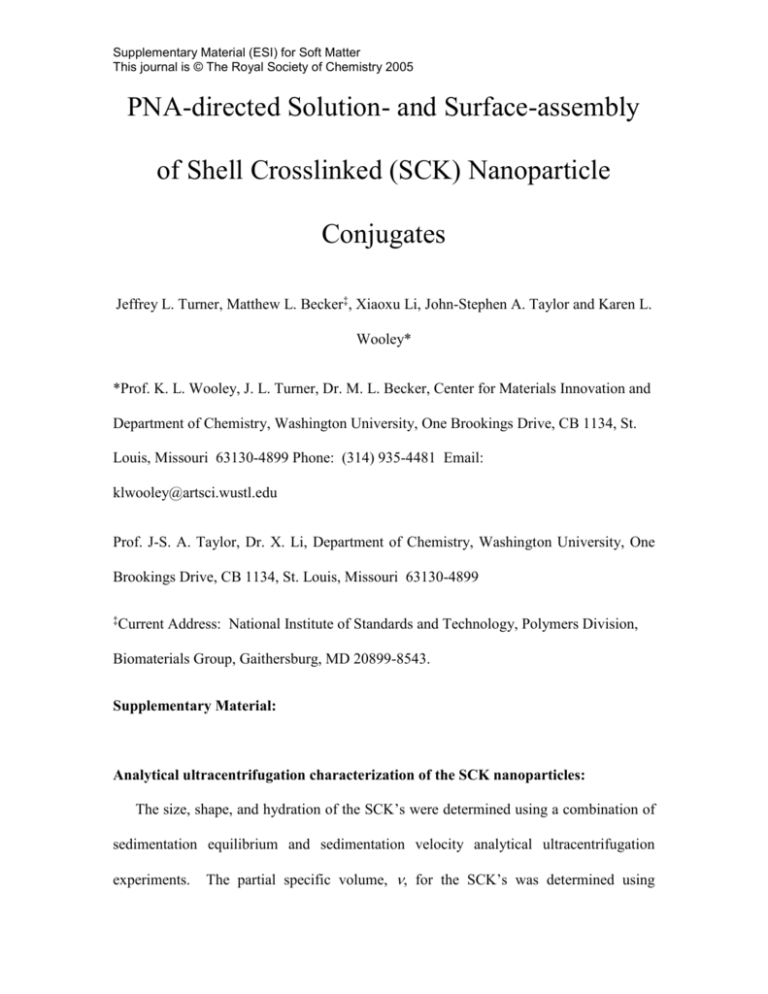
Supplementary Material (ESI) for Soft Matter This journal is © The Royal Society of Chemistry 2005 PNA-directed Solution- and Surface-assembly of Shell Crosslinked (SCK) Nanoparticle Conjugates Jeffrey L. Turner, Matthew L. Becker‡, Xiaoxu Li, John-Stephen A. Taylor and Karen L. Wooley* *Prof. K. L. Wooley, J. L. Turner, Dr. M. L. Becker, Center for Materials Innovation and Department of Chemistry, Washington University, One Brookings Drive, CB 1134, St. Louis, Missouri 63130-4899 Phone: (314) 935-4481 Email: klwooley@artsci.wustl.edu Prof. J-S. A. Taylor, Dr. X. Li, Department of Chemistry, Washington University, One Brookings Drive, CB 1134, St. Louis, Missouri 63130-4899 ‡ Current Address: National Institute of Standards and Technology, Polymers Division, Biomaterials Group, Gaithersburg, MD 20899-8543. Supplementary Material: Analytical ultracentrifugation characterization of the SCK nanoparticles: The size, shape, and hydration of the SCK’s were determined using a combination of sedimentation equilibrium and sedimentation velocity analytical ultracentrifugation experiments. The partial specific volume, , for the SCK’s was determined using Supplementary Material (ESI) for Soft Matter This journal is © The Royal Society of Chemistry 2005 methods described previously[2] that employed sedimentation equilibrium profiles collected for the SCK’s dispersed in chemically identical (H2O and D2O) buffers of different densities. As shown in Figure 1A, linear SE plots were obtained by plotting the log (fringe displacement) versus r2/2 from which the slopes of the plots were determined and was computed: = [k-(D /H)]/[(D -H (D /H)] Where D is the density of the deuterated buffer, and H is the density of the protonated buffer, and k is the ratio of the molar masses for the SCK’s in deuterated solution to the SCK’s in protonated solution. After determining the partial specific volume, a sedimentation velocity experiment was performed to determine several additional parameters. Figure 2B depicts a single boundary for the SCK’s, which is indicative of a single sedimenting species. The distribution of mass of the SCK nanoparticles was represented by the generation of a sedimentation coefficient distribution from the timeaveraged derivative (g(s*)) of the sedimentation velocity boundaries shown in Figure 3C. Figure 3C shows a series of sedimentation distributions at four different concentrations. The mono-modal distributions with overlapping sedimentation coefficient (s*) at the respective concentrations represents the most probable value of the sedimentation coefficient, which was measured to be 13.6. The value of s20,w was found to be concentration independent, which is a signature of macromolecules possessing spherical shape.[3] When all the parameters are corrected to their standard values at 20 °C in water, the coefficients are used to derive the peak molecular weight, Mp using the Svedberg equation.[4] Supplementary Material (ESI) for Soft Matter This journal is © The Royal Society of Chemistry 2005 The aggregation number, Nagg, or number of chains per particle, can be approximated by the ratio of the peak molecular weight, Mp, of the particle to the equivalent molecular weight of the 50% crosslinked amphiphilic block copolymer precursor, M0. Using the molecular weight of the nanoparticle, 5, 555,000 Da, the equivalent molecular weight of the 50% crosslinked precursor, 3, 21,400 Da and the appropriate error analysis, the aggregation number, Nagg, was found to be 27 ± 3. The diameter of the anhydrous sphere, D0, was calculated to be 10.6 nm which is within the level of experimental error when compared to the core diameters, Dav, as measured by TEM, 9.7 ± 1.3 nm, and average particle heights, Hav, as measured by AFM, 7.2 ± 1.3 nm, respectively. The standardized frictional coefficient, f20,w, of the SCK was measured and the frictional coefficient, f0, of the anhydrous sphere was derived from the calculated diameter and buffer viscosity. Additionally, the degree of hydration, m, in the SCK was found to be 4.99 g H2O/g SCK, indicating that the shell layer of the SCK nanoparticle is composed largely of water and is much larger that the degrees of hydration measured in globular protein macromolecules which fall in the range of 0.2-0.6 g H2O/g protein,[5] but is comparable to the 3.0-4.0 g H2O/g particle reported in the literature for water soluble core-shell casein micelles.[6] Such a large hydration value is easy to imagine when examining the volume ratios between the sphere calculated from the hydrodynamic diameter and the diameter of the anhydrous sphere. From this ratio, the calculated volume of the shell is 4951 nm3, which is 89 % of the total volume in the nanoparticle (5575 nm3). When the estimated free volume of the poly(acrylic acid) portion of the block copolymers, 157 nm3, is subtracted, the shell volume is composed Supplementary Material (ESI) for Soft Matter This journal is © The Royal Society of Chemistry 2005 primarily, 96.8%, of water. The summary of characterization data from the two analytical ultracentrifugation experiments is reported in Table 1. Figure 1. Analytical ultracentrifugation is a powerful characterization tool from which many physico-chemical parameters may be extracted. The log (fringe displacement) versus r2/2 plot for determining the partial specific volume, , of the SCK is shown in A. The single sedimentation boundary of the SCK in B as determined from a SV experiment is indicative of a single component species. The boundaries shown are of every tenth interferometry scan taken over a 90 min span. The concentration independent overlap illustrated in panel C at identical sedimentation coefficient, s*, is a signature for spherical particles and accurately portrays the molecular weight heterogeneity of the SCK sample. Supplementary Material (ESI) for Soft Matter This journal is © The Royal Society of Chemistry 2005 Table 1. Summary of Characterization Data Acquired for the SCK Nanoparticles Utilized for the PNA conjugation. References: [1] Murthy, K. S.; Ma, Q.; Clark, C. G., Jr.; Remsen, E. E.; Wooley, K. L. Chem. Commun. 2001, 773-774. [2] Remsen, E. E.; Thurmond, K. B., II; Wooley, K. L. Macromol. 1999, 32, 36853689. [3] Murthy, K. S.; Remsen, E. E.; Wooley, K. L. J. Mater. Chem. 2003, 13, 2785. [4] Svedberg, T. Nature 1929, 123, 871. [5] Svergun, D. I.; S., R.; Koch, M. H.; Sayers, Z.; S., K.; Zaccai, G. Proc. Nat'l Acad. Sci. USA 1998, 95, 2267-2272. [6] Morris, G. A.; Foster, T. J.; Harding, S. E. Biomacromol. 2000, 1, 764-767
